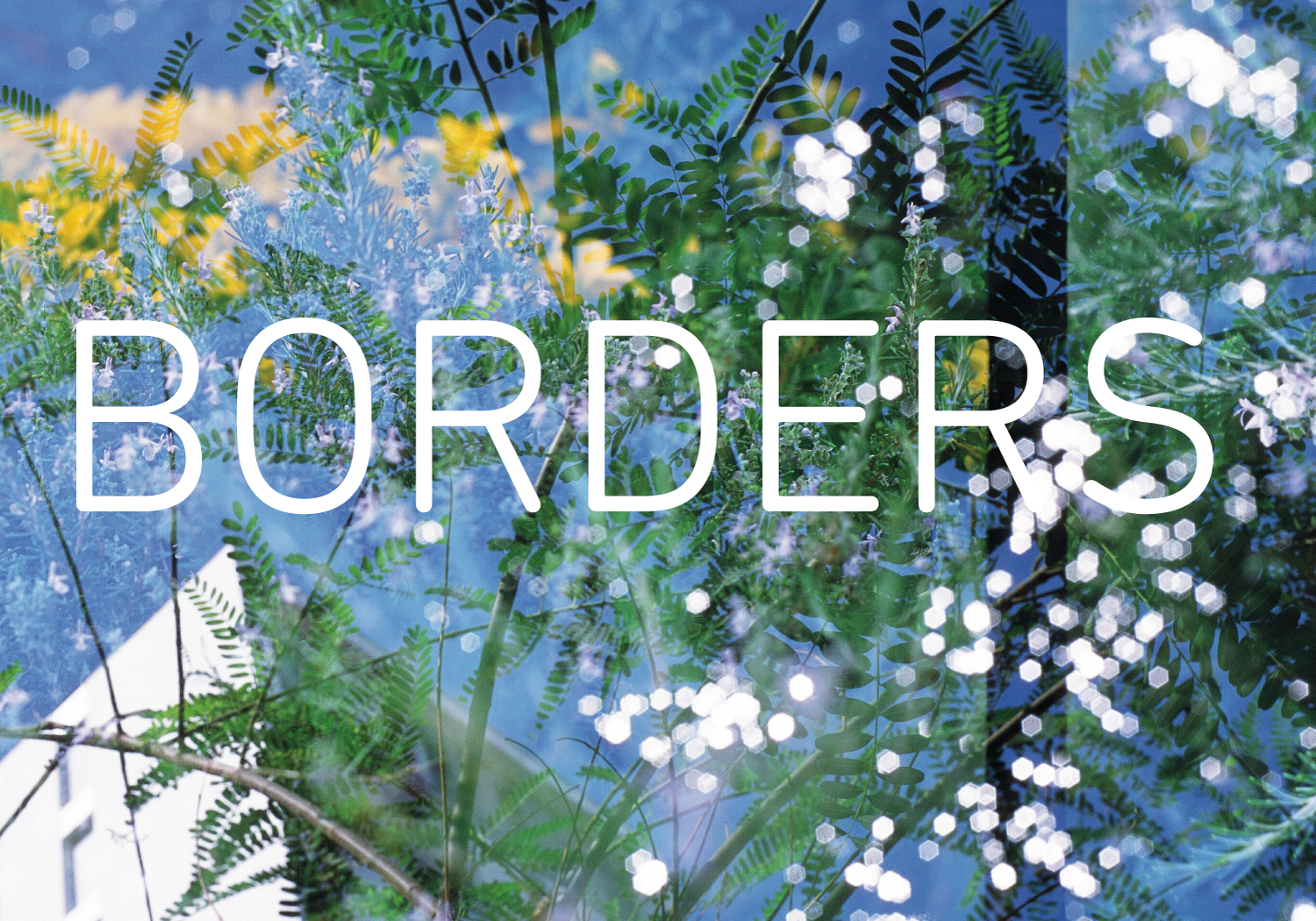
© Nicola Jayne Maskrey
Photographers from the UK and around the world are currently exhibiting their work in BORDERS (showing at Bridewell Theatre, London until 16th April), an exhibition of photography, curated in response to the MARCHLAND season of performances and talks, in collaboration with Théâtre Volière and the Bridewell Theatre.
MARCHLAND brings together artists, musicians and dancers to share remarkable stories and complex histories. You can find out more information about this project here.
We were overwhelmed with responses to the call for entries, with over 200 works submitted. We were limited by space, but we wanted to show some of the submissions that didn’t make it into the exhibition at Bridewell Theatre. There was such a high volume of excellent entries, and we felt this work should also be seen.
So we’ve decided to share a selection of this work via the Shutter Hub blog. This online exhibition of supporting materials demonstrates the breadth of interest and thought on this topic, and offers insights by showing the images alongside descriptions and thoughts from the photographers.

Act 1, Year 1, November; from The More That Is Taken Away – Ben Altman
Try to praise the mutilated world — Adam Zagajewski
I excavate an earthwork and use it as a site. I work alone, with hand tools, behind my house in rural upstate New York. The piece is in three Acts.
The image is from Act 1, in which I mark out an 18m by 3m rectangle and excavate linear volumes within those borders. The shapes evolve in response to the forms themselves and as I repair damage by vegetation and weather. The result, after several years, is an empty pit reminiscent of a mass grave. The piece uses a strictly circumscribed frame to address formative histories of violence.
Ben Altman is showing an image from this series in the exhibition at Bridewell Theatre.


Flower Flower Water Light – Nicola Jayne Maskrey
A travel diary of chaotic beauty and colourful abstraction, documenting a 3 week road trip through the landscapes of the UK, France, and Spain. Avoiding any deliberate regional classification, I allowed the images to form chronologically throughout my own journey and experiences, unifying the three countries into one emotional state. Using triple exposures on 35mm slide film I chose to blend and to overlay flowers, plants, the land, and ripples of sunlight on the surface of the sea, thereby recording my journey in a series of ethereal images that emulate memory and movement through time and place.
Nicola Jayne Maskrey is showing an image from this series in the exhibition at Bridewell Theatre.

Leaving France – Joe Jacob
This is part of the French coast. The image was shot on the ferry just outside Dieppe.

Border provocation, from the series Beyond Orwell – Christiane Zschommler
I was brought up in a block of flats overlooking the strip of no-man’s land behind The Wall in Berlin in full view of the watch towers, guard dogs attached to a wire and flood lights illuminating the strip of forbidden territory. There was no access to the other side. Unknown numbers of people suffered from distress and despair in their personal lives as a consequence of this monstrous structure. 139 people died at The Berlin Wall between 13th August 1961 until 9th November 1989. Stasi officers posing as policemen would inform the relatives and deaths would be stated as being due to “a border provocation of his own causing”, “a fatal accident of his own causing” or “drowning in a border waterway”.
This image is showing in the exhibition at Bridewell Theatre.

Who is Brin? – Barry Cawston
This is a photograph of a piece of graffiti I did with a Palestinian street artist, on an old garage next to the separation wall in Bethlehem. It incorporates Glastonbury Tor (which was where the first Who is Brin? occurred) echoing the guard tower in the background.
It was only the second time in my life where I have seen an inverted rainbow.
This image is showing in the exhibition at Bridewell Theatre.


Target Practice – Amanda Jobson
Target Practice is an on going body of work examining the subject of a Military Firing Range in Kent. The visual representation relating to, borders, divisions, territories, cultural identity. The project consists of constructed objects made and photographed in the landscape (Targets) and the signs of nature, around the military range. I made many coastal field trips; these reconstructions are part of this major body of work. During the research I listened to ex soldiers, their memories of training along this military range as one soldier recounts: “They took you on the ranges and beasted us on the shingles carrying these bloody heavy Bergan’s”.
Amanda Jobson is showing an image from this series in the exhibition at Bridewell Theatre.

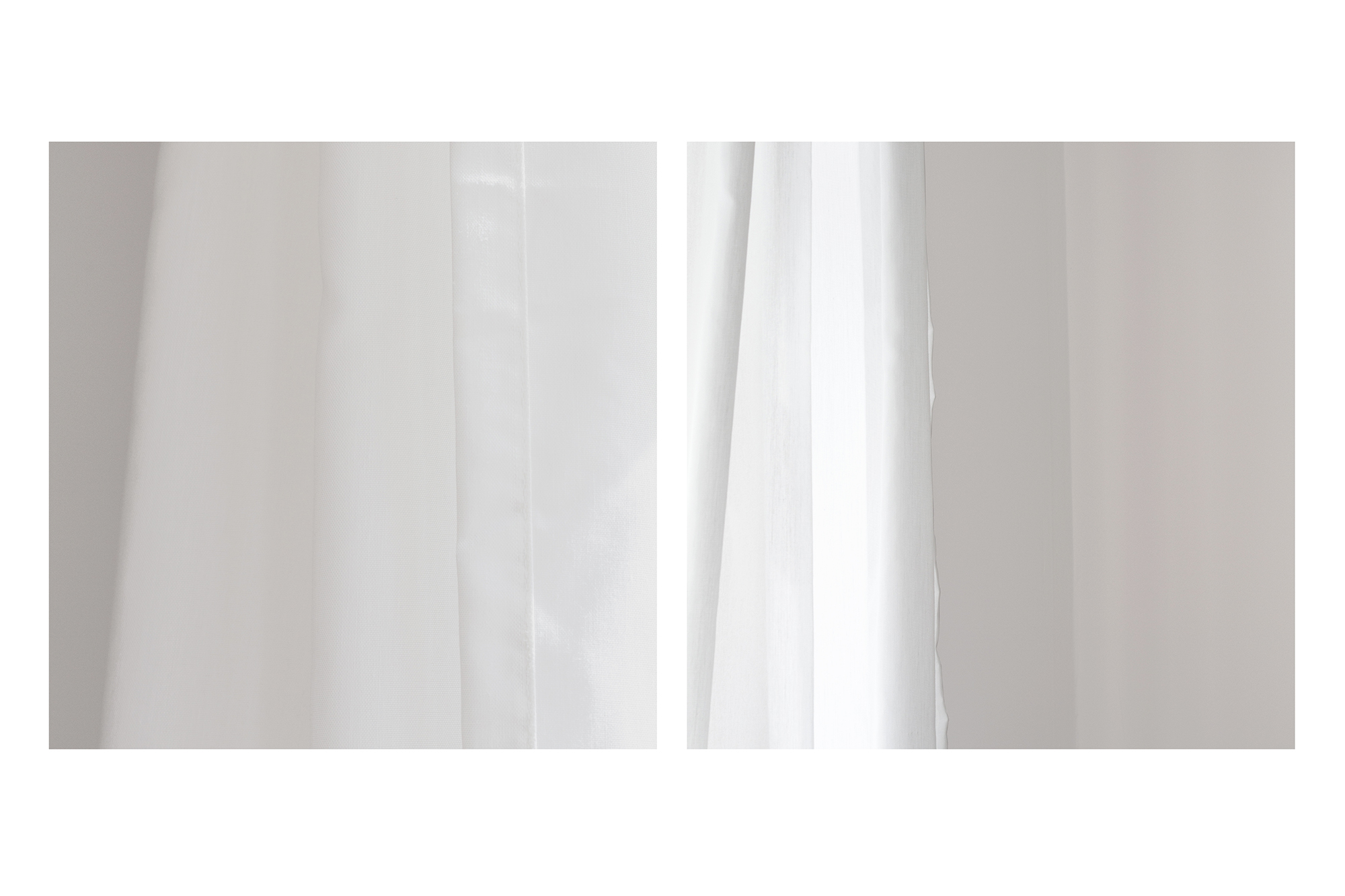
Lines – Silvia Szucs
Lines explores the perception of an empty space, drawing attention to the elements that represent the boundaries between the subject and the outside environment. Ironically, the alienation caused by the characterless surroundings and unfamiliarity of the space favours a degree of mental abstraction while the body remains confined.
Silvia Szucs is showing an image from this series in the exhibition at Bridewell Theatre.
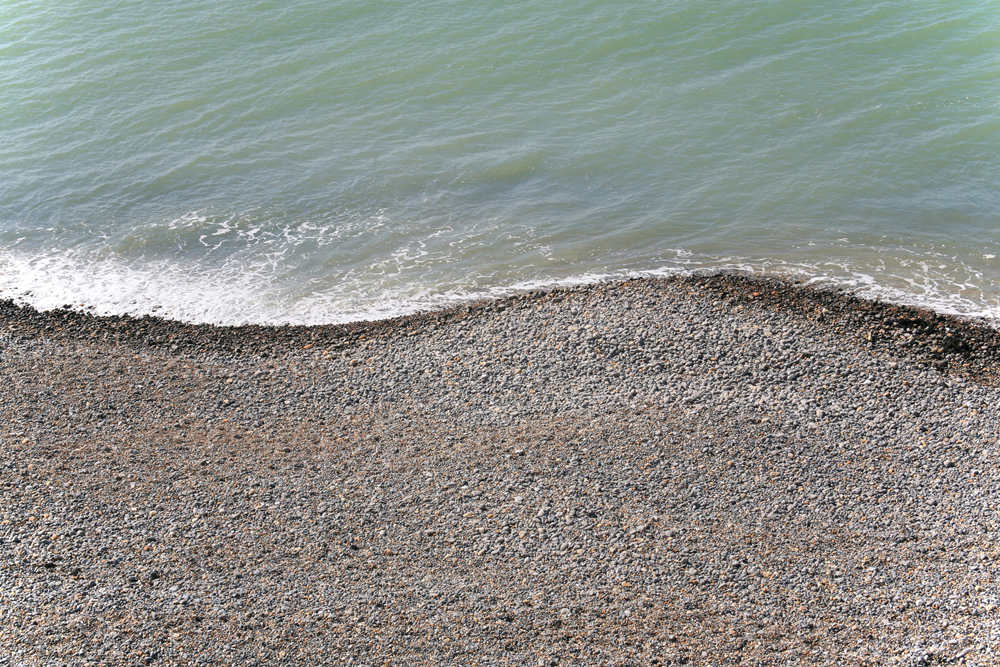
Curve – Ann Petruckevitch
You can't turn on the radio, television or follow news threads of late without the issue of political and immigration border control being topical. In my submitted image entitled 'Curve', which is part of an ongoing series examining delineation between a variety of materials that simply represent the nature around us, I'm exploring spatial connections without enforcement. There is a symmetry where the land and sea merge to meet each other, and I was drawn to the balance of the view between both, a subtle naturally occurring border where the movement of one fills the void exposed by the other, knowing that with a blink of an eye the shape formed may change in direction and context.
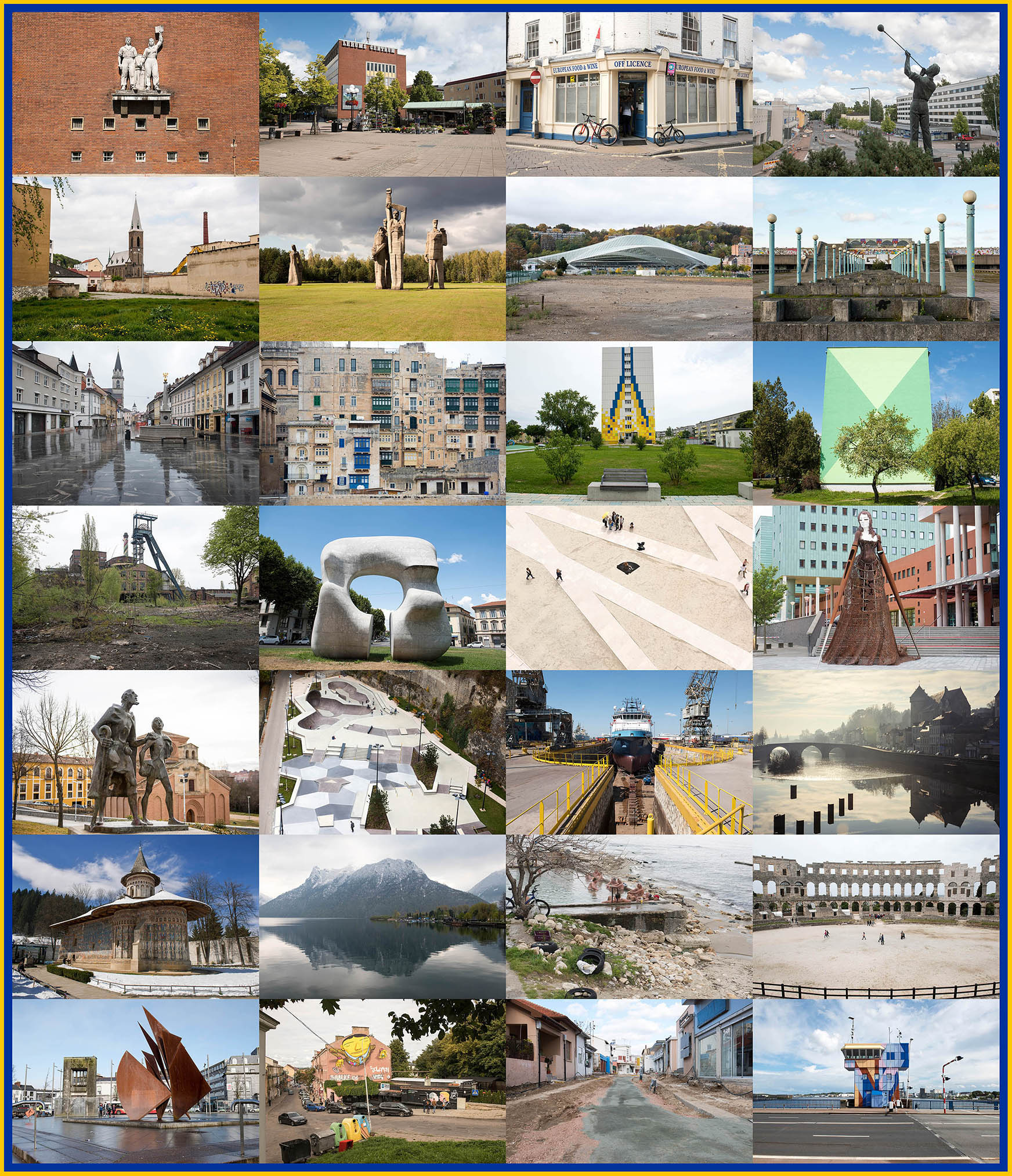
Project 28 Montage – Chris Gravett
In the summer of 2016 the news was dominated by the UK’s EU referendum. “Take back control of our borders” was often heard.
The EU consists of 28 disparate countries stretching from Finland in the North to Malta in the South, from Portugal on the Atlantic to Bulgaria on the Black Sea.
I travelled to and photographed/documented a single town in each of the EU states.
Project 28 Montage is made up of an image from each of the 28 states enclosed in the blue and yellow EU colours.

The border comes and goes… – Marianne van Loo
As a child in Holland, I grew up a few metres away from the German border. Remarkable was that on one side of the 'new' street, the houses were located in Germany and on the other the houses were in Holland. Over the years, I literally saw the identification of the border change, after World War II, there was barbed wire in the middle of the road, later replaced by chain linked fencing. A tangible show of nationalism between two countries. This ended in 2002, now there is no visible border and the nations are working together as one.

I crossed the blue injunction line – Marianne van Loo
Not far from where I live, Cuadrilla is exploring shale rock for natural gas, boosting the country's position as Europe's most promising shale gas exploration ground. Documenting this process, I did not realise that there is now a 'border' in the form of a blue painted line on the pavement. If you look closely, by the legs of the police officers you will see the blue line, a border made out of paint to stop people from crossing…. All over Europe we are putting more and more hard borders… where will this lead humanity? Which voices will prevail in the end?
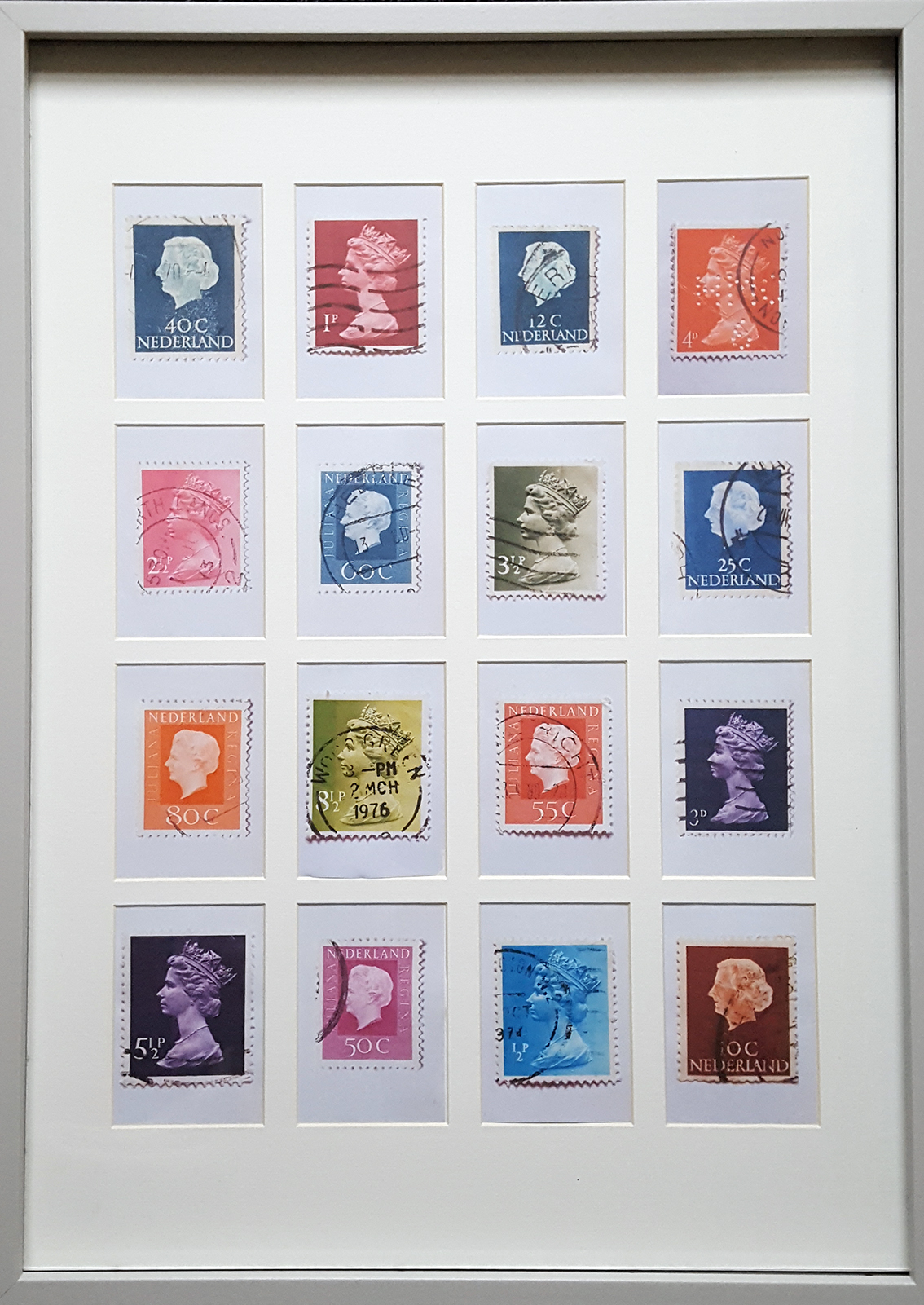
Awaiting a decision – Marianne van Loo
A highly personal piece of work, consisting of stamps I collected as a child. These stamps have now taken on a new meaning. As a European (Dutch) living in the UK for the past 22 years, my life was in disarray after Brexit. I crossed the border here in July 1995 and never could I imagine that my life as a European in Britain would be under scrutiny. I felt no choice but to apply for British Citizenship and soon I will have to swear alliance to the queen of another country to safeguard my future. Competing nationalism on a personal level…


“Schengen” – Ruth Stoltenberg
Schengen is a small Luxembourgian village at the border to France and Germany. Here, in the centre of Europe, the Schengen agreement to abolish intra-European border controls was signed in 1985.
Ruth Stoltenberg grew up in this border region in the 1960s and 1970s and has noticed that much has changed over the past few decades. In her photo project she was mainly interested in the influence this opening of borders had and still has on the different cultures and lifestyles of people from the three nations. Whether, apart from the different languages of the inhabitants, also visual differences in the villages are apparent. Whether, for example, national identities become evident based on houses, (front) gardens, streets or larger squares. Or whether this region, distinguished by viticulture and agriculture, still has its own unique, transnational charm.
The pictures shown here are part of a larger series that will soon be published as a photobook.
Ruth Stoltenberg is showing an image from this series in the exhibition at Bridewell Theatre.

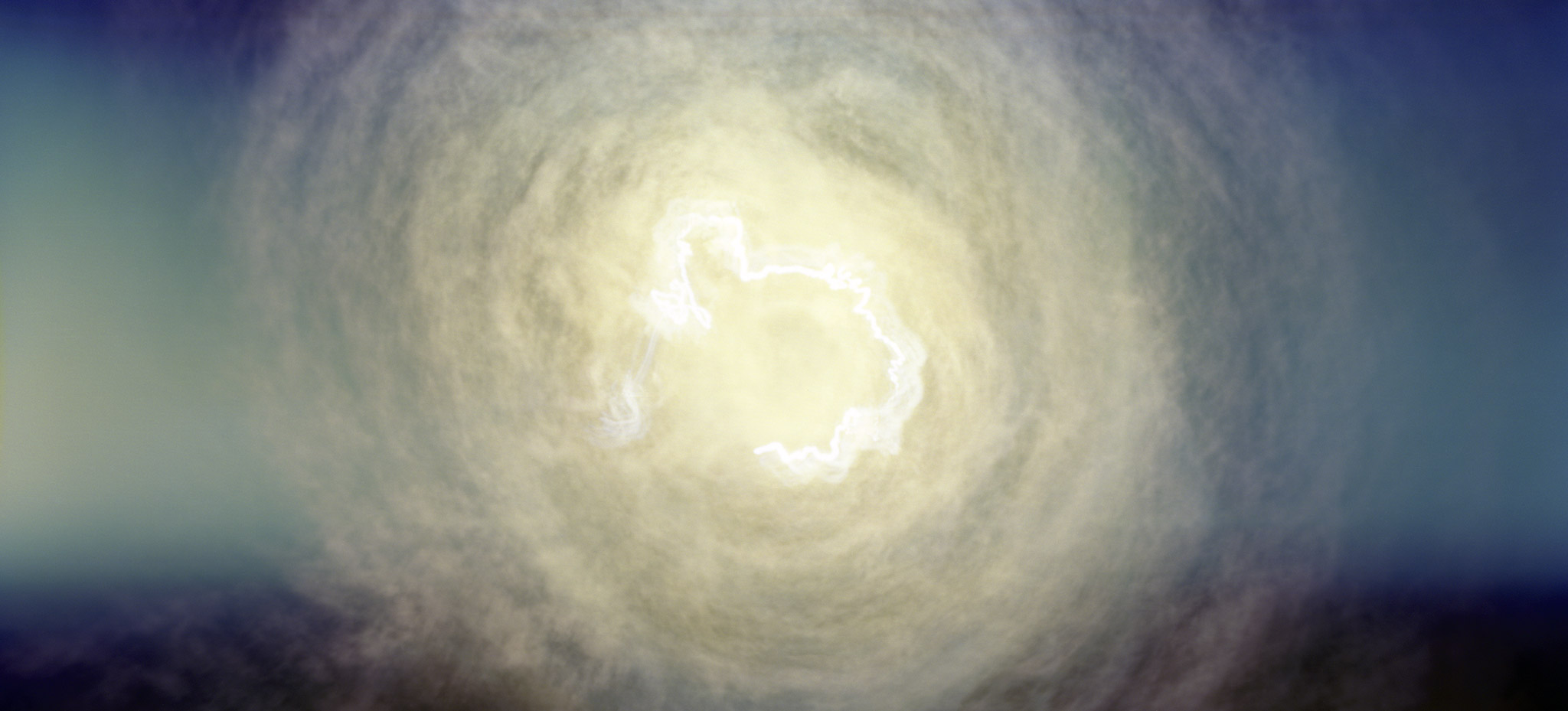
See what you see, don’t take my word for it – Joseph Thomas
Borders are constructed by words and frames and titles. Reflect on these interpretations of the world through another's eye.
Image-making has an evident physical mobility which corresponds closely to the desire of the photographer – the desire to cross cultural and physical borders.
To see the world and create original vision is possible, but this vision must be attained by viewing the world as a foreign land.
Joseph Thomas is showing an image from this series in the exhibition at Bridewell Theatre.

Human Borders – Susana de Dios
Simona (Italy):
“As a child, my idea of borders was essentially related to 'separation', to imaginary – and actual – lines shaping countries that introduced you to different languages and cultures.
Now I think of borders as blurred lines and society as a melting pot, where people from different countries come together, feel welcome and help each other. Unfortunately, Brexit with its isolationist ideas has again set very real physical borders.
Sometimes we forget how much we are all part of the same land. Personally, I really admire anyone who is brave enough to start a new life in a different country.”

Human Borders – Susana de Dios
Alzbeta (Slovakia):
“I am grateful for the opportunities this country has afforded me. Here I have finished my Bachelor’s Degree in Music and have had the chance to perform and become a music teacher.
Whether I continue to live here depends on the final deal on EU citizens and people’s attitudes towards us. I would love to be part of British society, but I don’t want to be looked upon with suspicion as someone who shouldn’t be here, or who is exploiting the system.
There are people out there who are much worse for society, and they don’t come from Eastern Europe.”

Human Borders – Susana de Dios
Maria (Spain):
“Borders are physical lines that separate countries, but they can also be perceived cultural or psychological frontiers that limit you.
I have never been able to fully grasp the concept of ‘borders’. In my mind they don’t exist beyond legal and physical constraints.
I left the UK a few months after the referendum. Brexit limited my options and made me feel threatened. There was this sense of separation and I felt like a second class citizen. It affected me both from a personal and a psychological point of view, so I chose to leave and start over again somewhere else.”
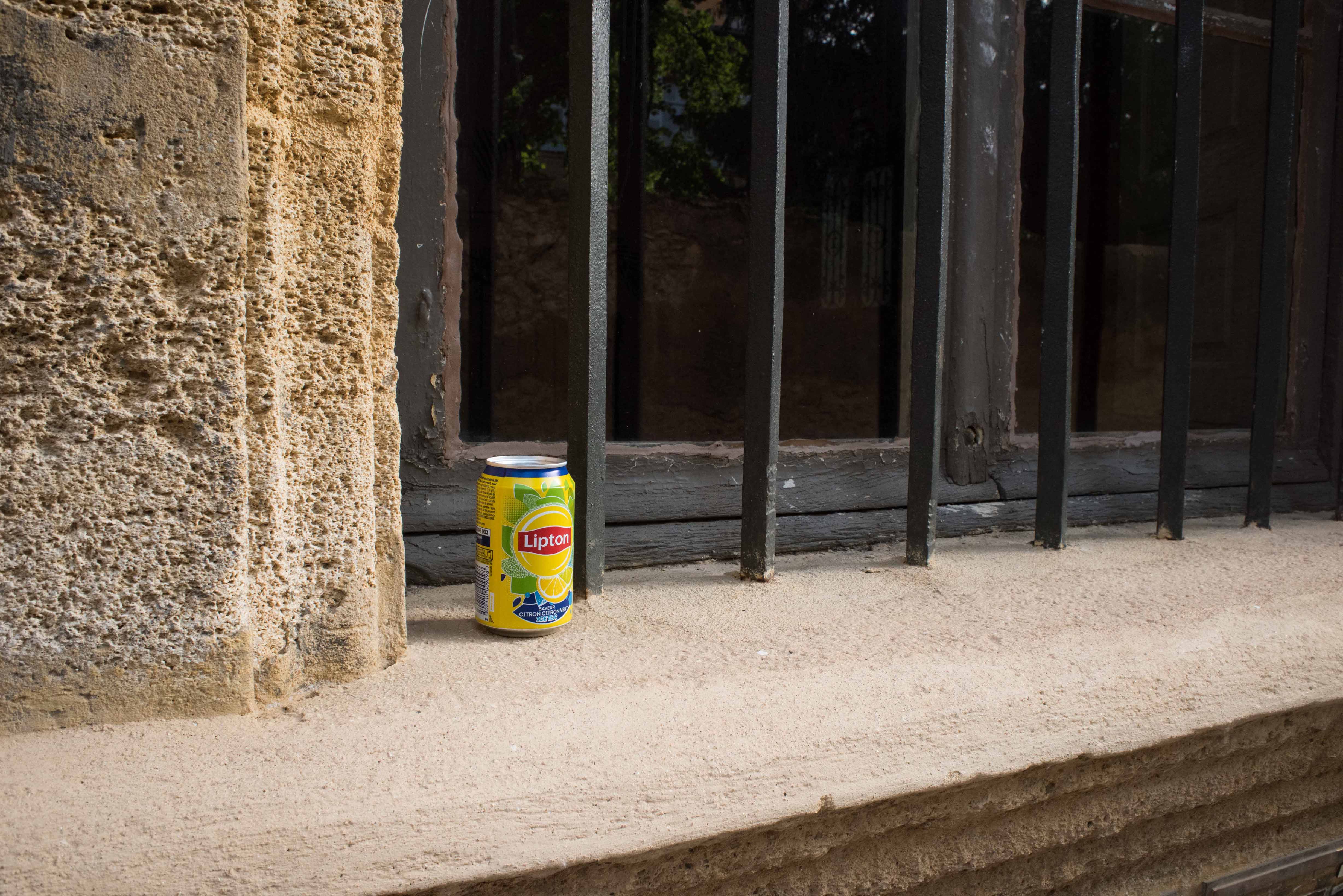

Between private and public – Wendy Aldiss
These images are part of a larger series based around certain human behaviours. The window ledge is an interesting border between the private home and areas where the 'public' dwell. Here, all sorts of items are left by those who do not live in the home that the window ledge belongs to. Why does this feel right to the person who leaves the item and what does the home owner feel? What do you think about the use, or misuse, of this border? Might this depend on what is left or on whose ledge it is?
Wendy Aldiss is showing an image from this series in the exhibition at Bridewell Theatre.

Texas/Mexico: El Camino del Rio – Sheila McKinney
El Camino del Rio, Texas Highway 170, runs from the border town of Presidio to Lajitas, in Big Bend National Park in Texas. It also runs close to the Rio Grande, the Texas/Mexico border.
The landscape is gritty and thankless. It’s hot, dusty, unpopulated and has no cellphone service. You don’t want to run out of gas! Life on the border is harsh.

Migrant Worker Heading West, Oklahoma, 1936 – Gavin Smart
Inspired by the FSA photographs of the 1930s, this image explores the powerful effects of economic instability on forced migration. During the Depression era, many workers left their homes to make a desperate journey across state borders in search of work.
The image is taken from my ongoing project combining scale model sets with composite portraiture, to produce a series of images akin to a low-fi or animated short film. The series is a meditation on the American Railroad, as a silent observer to some of the most tumultuous moments in the 20th Century.

No Borders #1 – Lizz Jattekritor
No Borders #1 is a personal perspective on and deconstruction of borders that limit not only a piece of land but endless territories in one's mind.
It is a conclusion to years of disturbing the tranquility of the secure axiom of beliefs, of cracking open the borders of traditions, of stretching beyond the boundaries set by society, of transgressing the confines of labels and of disjointing cultural impositions.
It is an embrace of the whole, a letting go of borders, an acceptance of all, a setting free of self.

Untitled – Richard Benedict
How, if nature abhors a vacuum, she doesn't care too much for borders either. A tree had grown through some fencing, and thence absorbed some of the fencing. When it came to removing the tree, various chunks were left behind in the fence itself.

Maunsell Sea Forts at Red Sands – Richard Benedict
All along the North Kent coast are fortifications dating from the Napoleonic Wars or even earlier. The Maunsell Sea Forts were built in the Thames Estuary for defence during World War II. Not a nice posting, one imagines. The English have ferociously defended their coastline for the last 1000 years. These are a familiar landmark (seamark?) to people in Whitstable; and this is the view from Whitstable Beach. I liked the way they were poking their way into the sky from the horizon. Image is visible red and infrared.
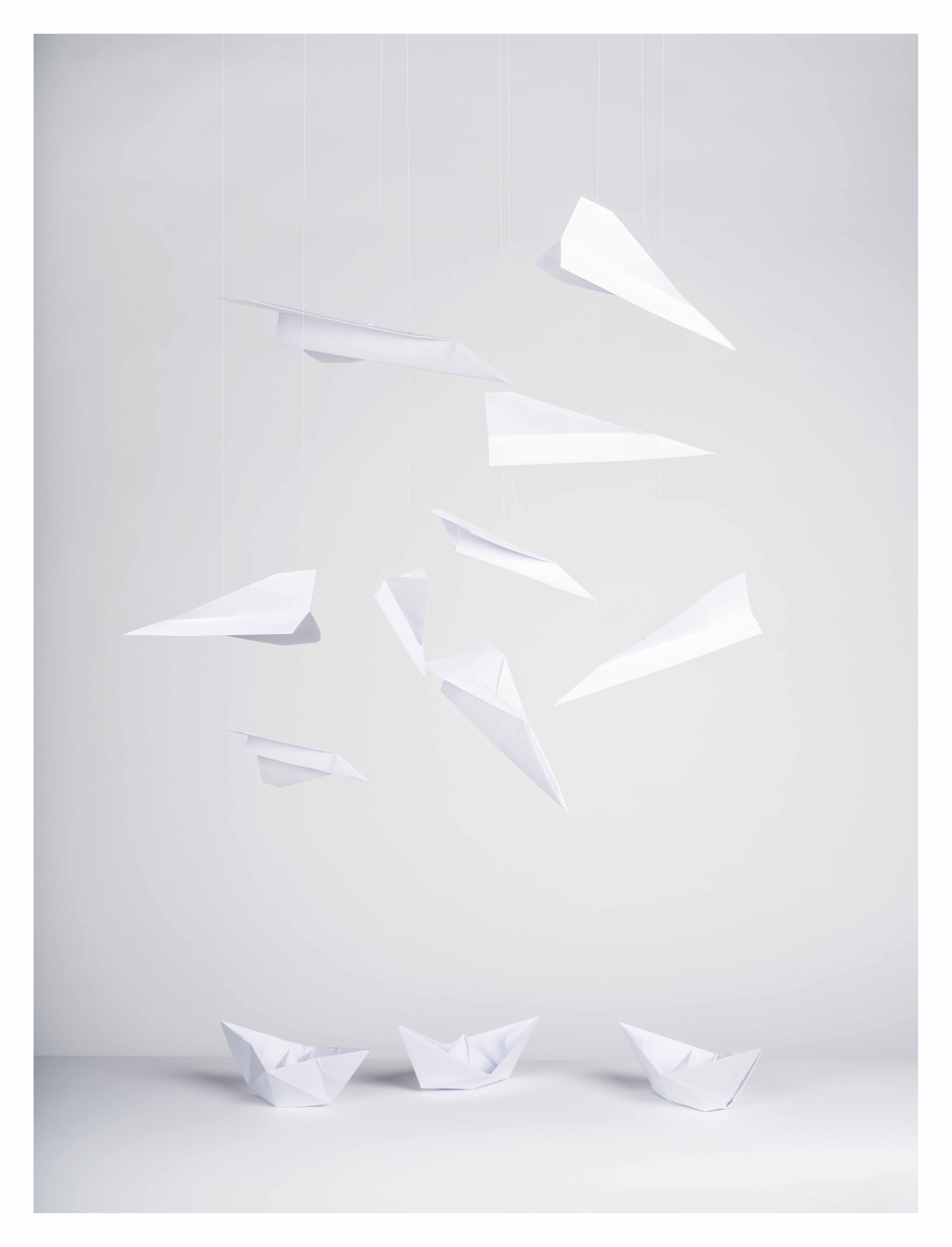
I’ve not been back in a long time – Patryk Majewski
This image is a part of a series of images which explore ideas of reminiscence and explore various symbols of childhood, both from the artist’s native country and the UK. Different objects are used in these images to investigate emotions in relation to personal connections. These particular objects represent and symbolise the migration period from one country to another. The use of paper planes show playfulness which reflects on the artist’s young age during these events.
Patryk Majewski is showing an image in the exhibition at Bridewell Theatre.

Dress unoccupied – Jo Stapleton
The dress has been removed from a Victorian style dolls house figurine. I found parts of the dolls body (arms, waist) concealed by the dress to be unarticulated as body parts – crudely shaped from pieces of foam and wire. I became interested in the role of the dress as a shell – a physical border between the dolls character and the illusion of a body beneath. The image was shot on ADOX CHS ART 25 film and Lith printed from the negative to give the dress presence and suggestion of the missing form beneath.

Hem – Jo Stapleton
This a constructed image exploring the idea of physical and decorative borders. Using macro and constructed realties photography techniques, the image is of the hem of a dolls house figurine dress – representing a boarder between social space and the intimacy of the body beneath, and a decorative border created by a dolls house checkerboard floor. The image was shot on ADOX CHS ART 25 slow speed b&w film and Lith printed.
Jo Stapleton is showing an image in the exhibition at Bridewell Theatre.

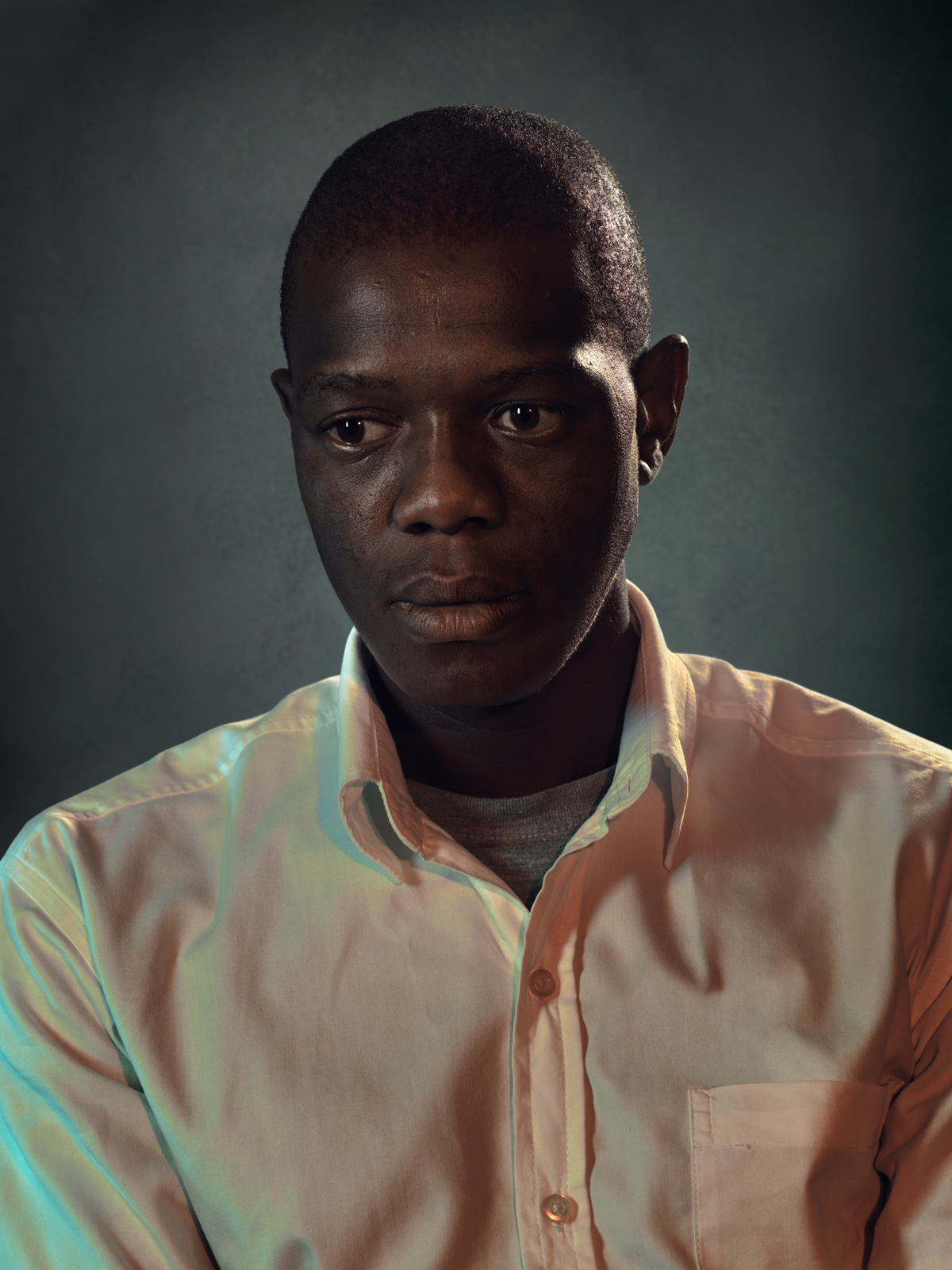
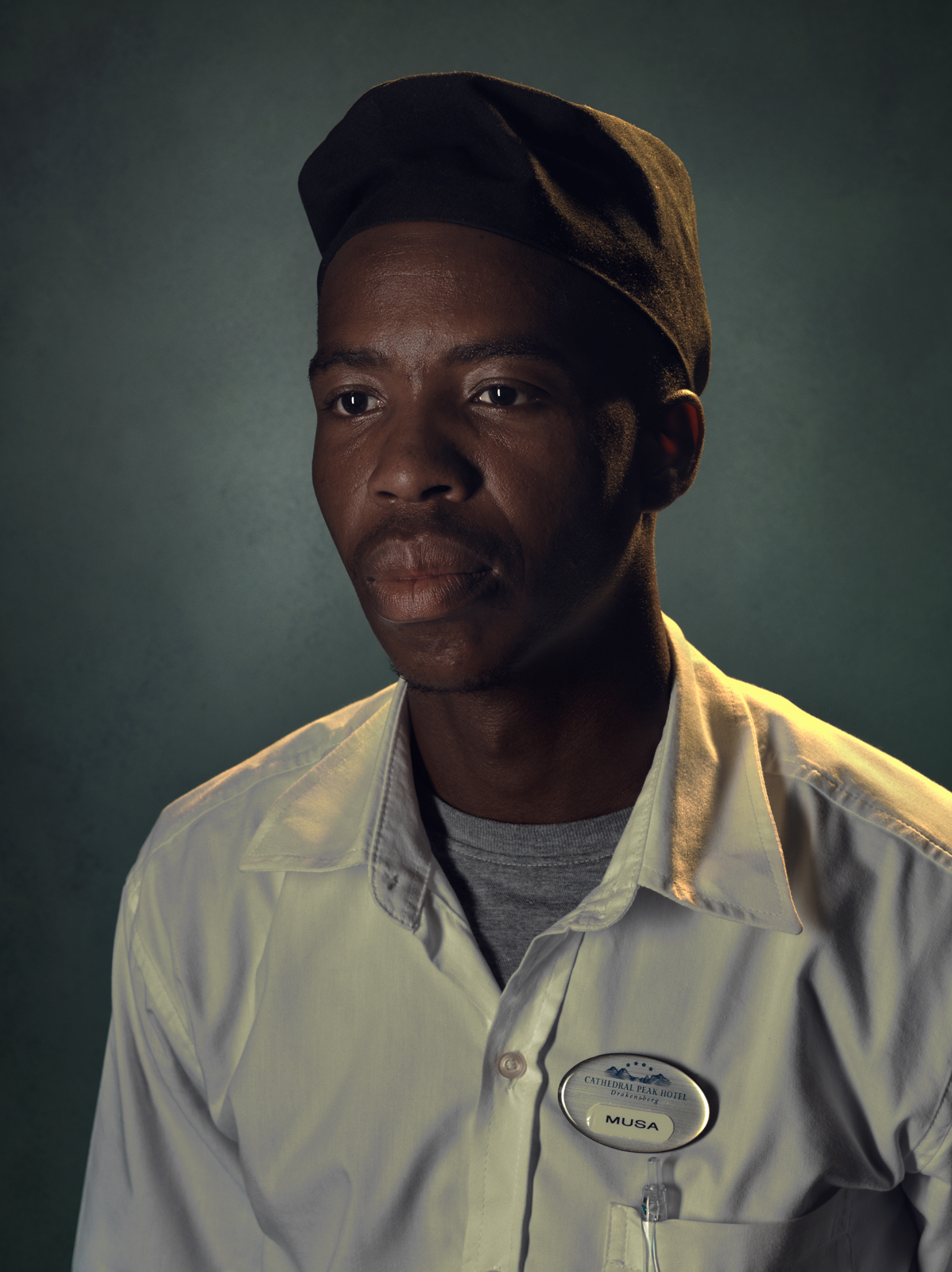
People on the Periphery – Eugene Grobler
This project stems from a recent trip into the heart of the uKhahlamba-Drakensberg mountains, a world heritage site located in KwaZulu-Natal, South Africa. In this region of the province the majestic escarpment forms a physical as well as cultural border, one that separates South Africa from the mountain kingdom of Lesotho, and by doing so, the Zulu people from their neighbours the Basotho. However, I was not here to climb the mountains, but rather to photograph a few of the people who, for generations, have called this place their home. I had contacted the Cathedral Peak Hotel – a nearby establishment providing a means of living for a small section of the local population – several months before my visit in order to request permission to photograph those members of staff willing to have their portrait taken. I wanted to give my sitters a voice, give them the chance to express themselves. I wanted to make them feel proud of who they are.
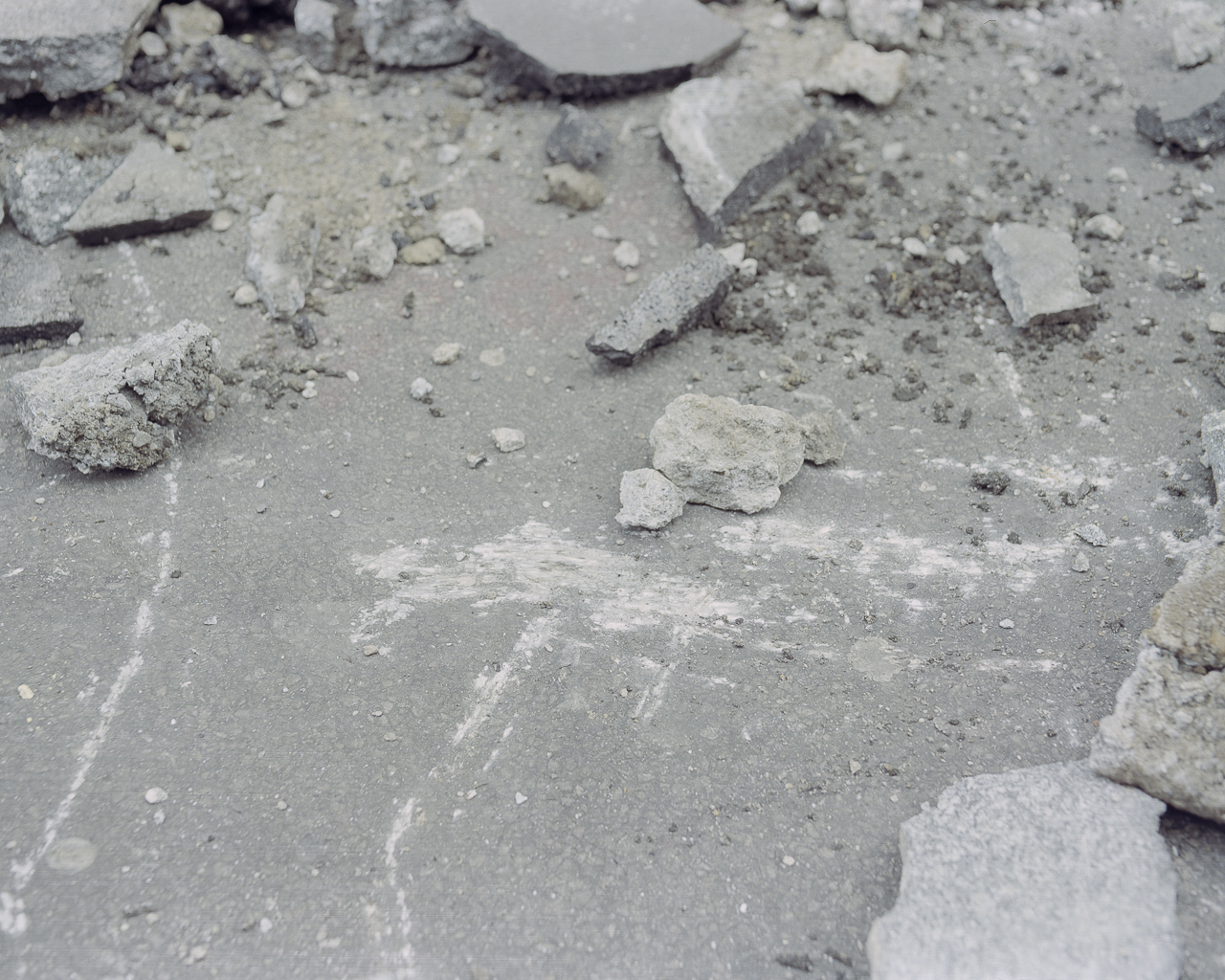
UK LDN W1 Berwick Street 2017_11 Roll 1 Frame 7 – Mal Woolford
Exploring and marking the landscape follows. Prospects and opportunities. Rights of way and rights of ownership. Marking maps with the graffiti of the civilising influence.
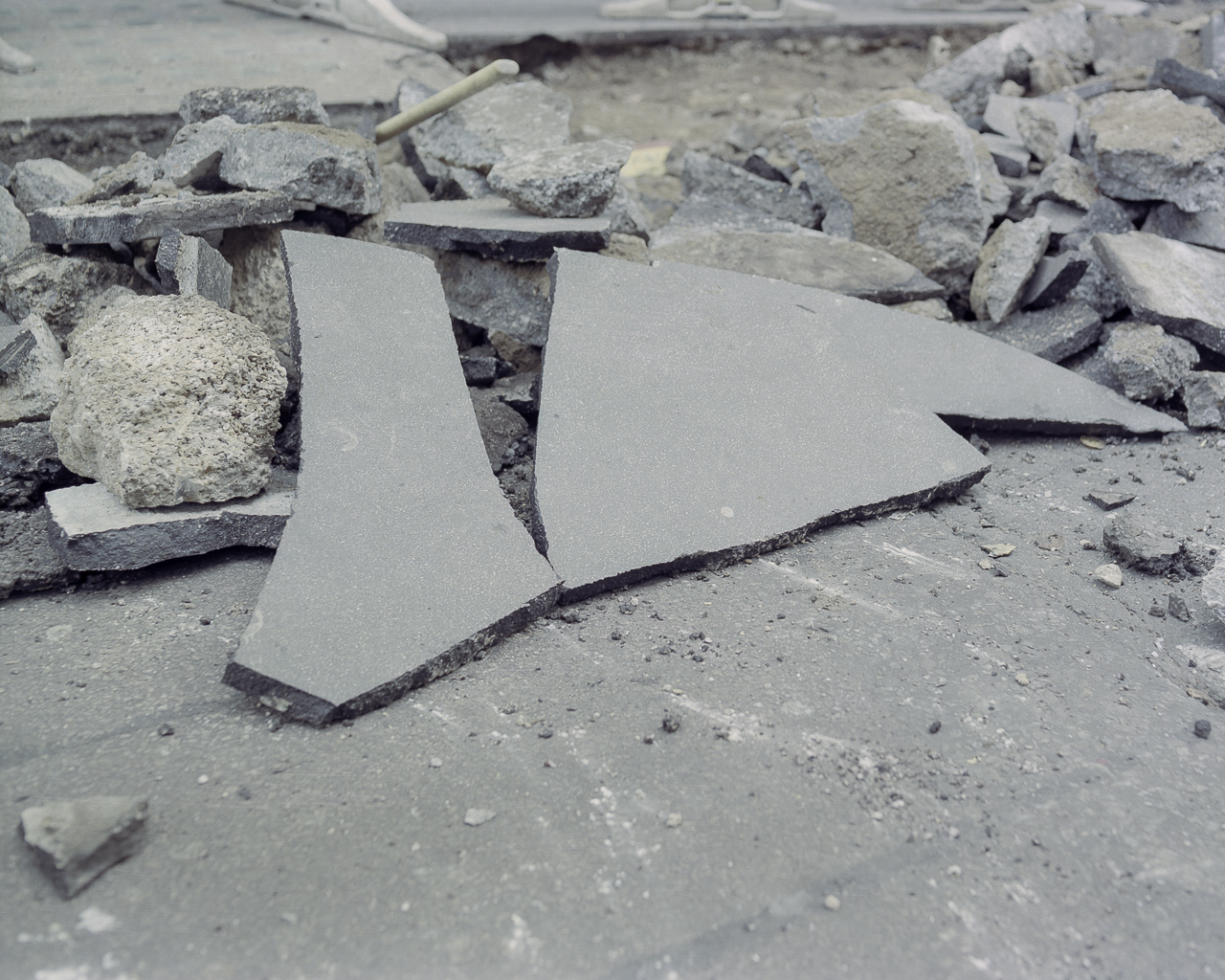
UK LDN W1 Berwick Street 2017_11 Roll 1 Frame 10 – Mal Woolford
And all the while, tectonic plates shift and continents drift with the power to shake atlases and land registries from their shelves and swallow them.
Mal Woolford is showing an image from this series in the exhibition at Bridewell Theatre.


Halophilous – Tamsin Green
The photographs for Halophilous were taken at saltworks on the periphery of European towns and cities. Some of the sites are still in use, others preserved as tourist attractions or health spas following a decline in small-scale salt production. The field images are combined with photographs of found specimens and google satellite images to create an alternative guide to salt.
Salt comes from the sea; dead, vanishing and living ones. As bodies of water appear and disappear they deposit salt. Looking at salt traces allows us to travel back through geological deep time where scale is adrift; as small as a grain of salt, as big as a salt mountain; an ocean died 40 million years ago, a pool of sea water will disappear tomorrow.
Tamsin Green is showing an image from this series in the exhibition at Bridewell Theatre.

My Father’s land – Tina Reid Peršin
A series about my father’s wartime experiences between the ages of 15 to 18. He was fighting the communists in Slovenia. He was on the borders between life to death and boy to man.
Life/Death 2 – Tina Reid Peršin
In Life/Death 2 the image is a hole in the roof of his family’s farmhouse and the sheeting which channels the rain into a bucket. It’s here he received the news that his brother died fighting the Communists – the subject of the quote. It is fitting that the house is not whole anymore as the entire family were separated.

Life/Death 3 – Tina Reid Peršin
In Life/Death 3 the images are of my father, his friends, his mother and the family farmhouse. It describes how the crossing of the border meant the difference between life and death. They were subsequently separated into age, my father was still technically a child soldier (just under 18) although he could have been deemed a man. All the adult soldiers were executed.
Tina Reid Peršin is showing an image from this series in the exhibition at Bridewell Theatre.

in the state of… – Henrik Hentschel
With school maps I learned how the world is structured and divided by individual political territories. I learned where I was living, what the neighbouring countries are and, being raised in East Germany, which areas I could not visit. I learned something about distance and vicinity. A certain picture of the world was formed.
This image is showing in the exhibition at Bridewell Theatre.


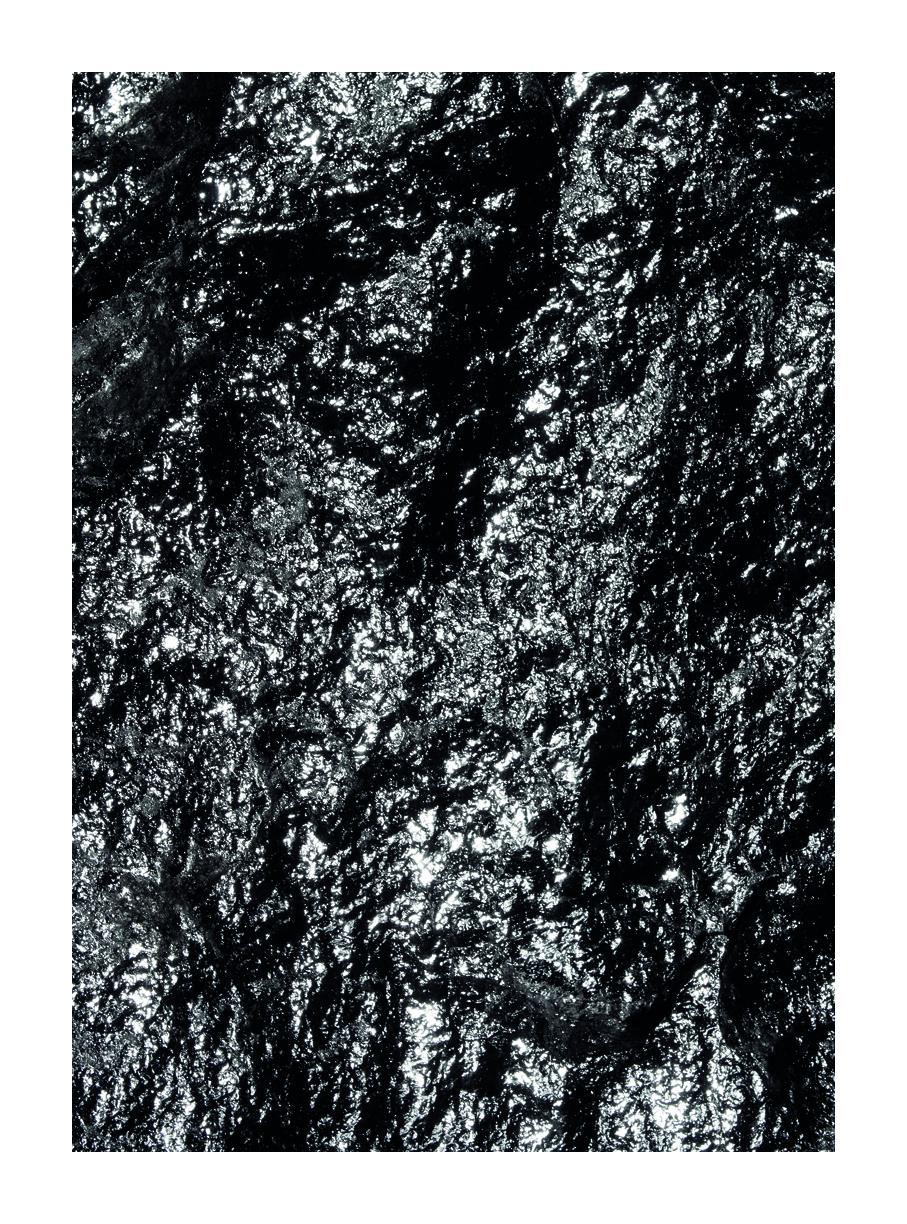
Untitled images from the 'Fragments' series – Michael Whelan
In his new body of work Fragments (2017), Michael explores the notion of dissecting landscapes by physically deconstructing mountain peaks, bringing to question the value that we place on these peaks. Working for the first time with sculptural processes seamlessly combined with his photographic style to elevate nature to an iconic and desirable status. The tones and compositional balance that appear in his photographs are transferred to 3D objects, maintaining the tranquility that exists in his work whilst being gently observed, influenced by scale, geological and topographical mixed media observations.
Michael Whelan is showing an image from this series in the exhibition at Bridewell Theatre.

IS Child Soldier, Omar Sharif, Hands, Dagens Nyheter, 18th July 2015 – Sarah Tulloch
Borders we take as standard have been breached in the subjects of this work – from the shooting down of MH 17 to the use of child soldiers. The photo material cut in horizontal bands and the intertwined hands reinforce this slicing of certainties.
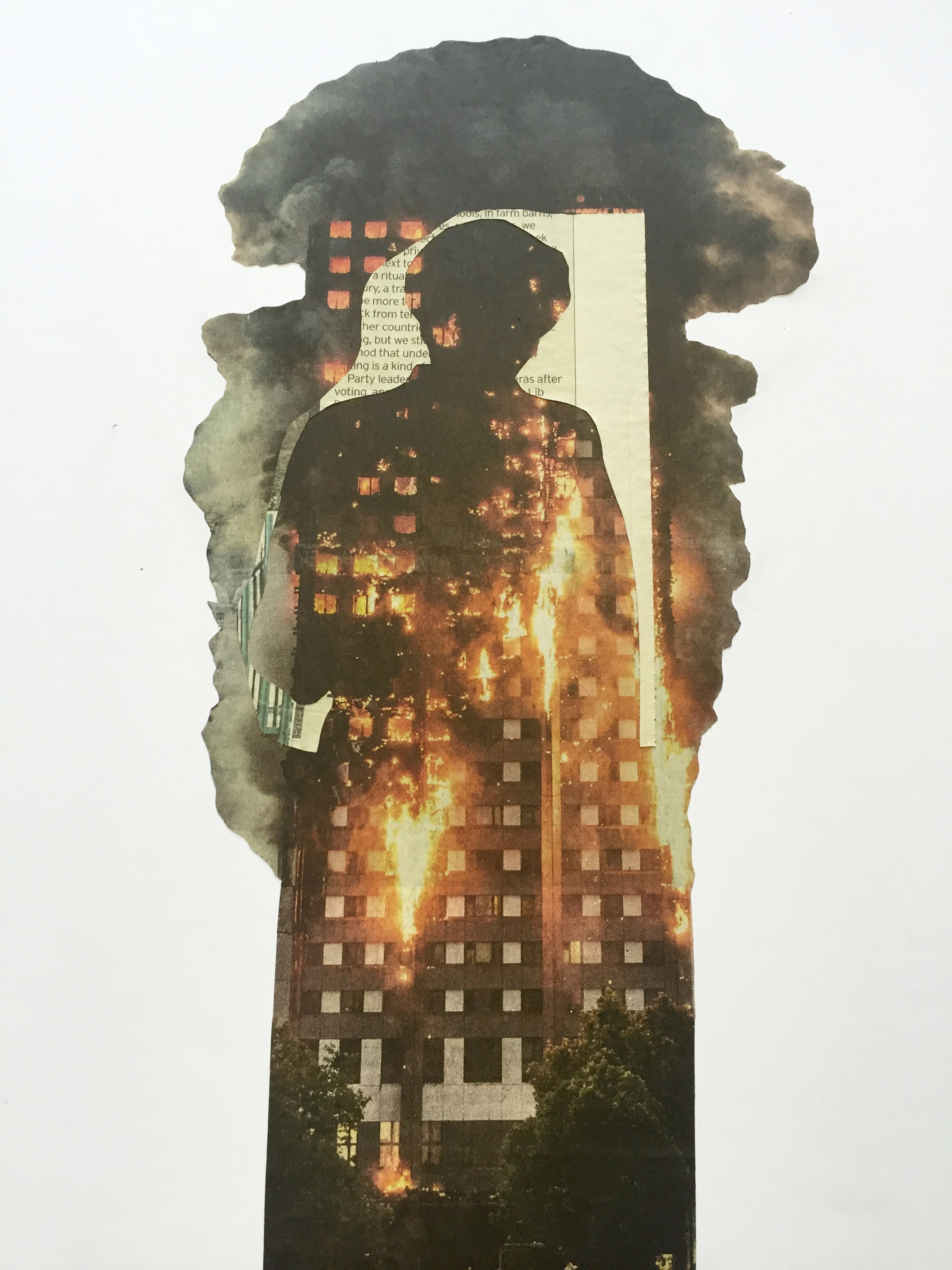
The Guardian, Thursday 15th June 2017 – Sarah Tulloch
The Grenfell tragedy exposed borders within borders. We do not have to look 'beyond' our island or at physical borders to find the results of invisible, insidious border making. Like many others I struggled to comprehend that in one of the most wealthy boroughs of London it was possible for this to happen.
Sarah Tulloch is showing an image from this series in the exhibition at Bridewell Theatre.


A Mile Apart – Lynne Connolly
The series ‘A Mile Apart’, explores a small geographical ward in East Belfast where a family moved house 11 times in as many years, each move was less than a mile away from the previous house. The moves took place in Belfast during the Troubles of the 1970s, borders and boundaries were and still are key flash points where communities intersect. The series uses layering of image, tilt-shift focusing and stitching into the materiality of the final print.
Lynne Connolly is showing an image from this series in the exhibition at Bridewell Theatre.

Borderlands: The Edges of Europe – Paola Leonardi
“Borderlands: The Edges of Europe” is a collection of analogue photographs representing the people and places along the borders of the European Union. Since 2012 I have photographed along the land borders of the European Union, following methodically the boundaries traced on maps, building a distinctive experience of the European frontier that includes unplanned encounters with its inhabitants.
This series focuses on the connection between people and territory and the significance of trans-national and transcultural identities, exploring the relevance of European identity and its relationship with concepts of home and belonging, memory and territory and how these have been shaped by events.
This project concentrates on land borders, and the concept of geographical Europe is juxtaposed to that of political Europe/European Union.
Danube Overflown, Border Serbia-Croatia – Paola Leonardi
A man stands in front of his house that has been overflown by the Danube.
The Danube forms a natural border between Serbia and Croatia, this image was photographed on the Croatian side, in the town of Aljimas. The Danube played a vital role in protecting Croatian civilians from the invading Serbian troops during the Balkan War, when the inhabitants of Aljimas hid in the muddy waters of the river.
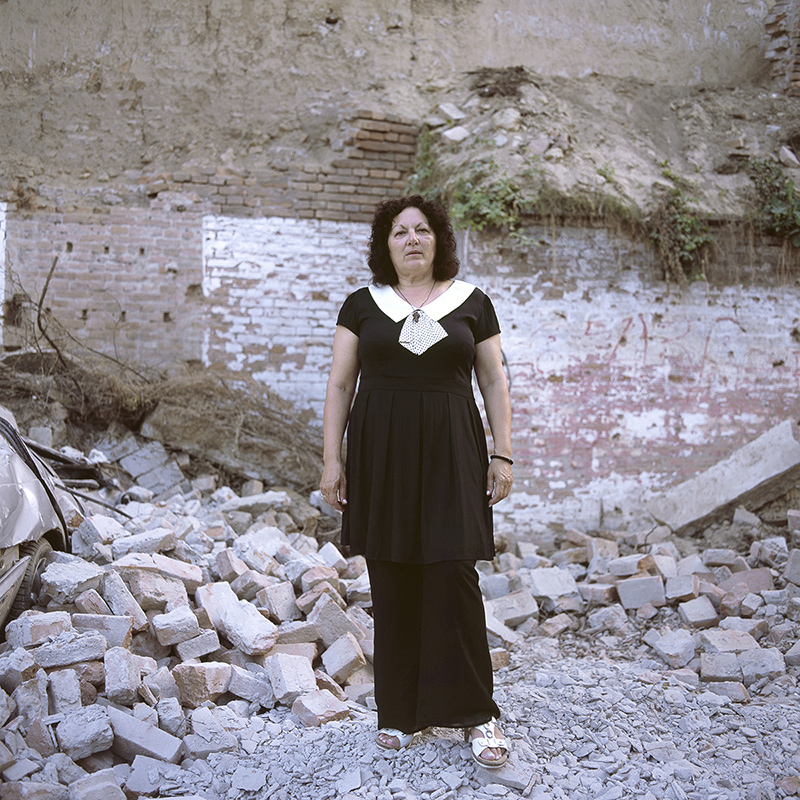
Zara, Border Serbia-Croatia – Paola Leonardi
Zara, photographed in the Croatian town of Vukovar, stands of the rubbles of her old house, destroyed during the Balkan War. She has rebuilt a house next to it and runs a B&B. She told me she is a Serbian but has lived in Croatia all her life. She says people don’t like her because she is Serbian but says she had no partaking in the war and considers Vukovar her home.
Paola Leonardi is showing an image from this series in the exhibition at Bridewell Theatre.
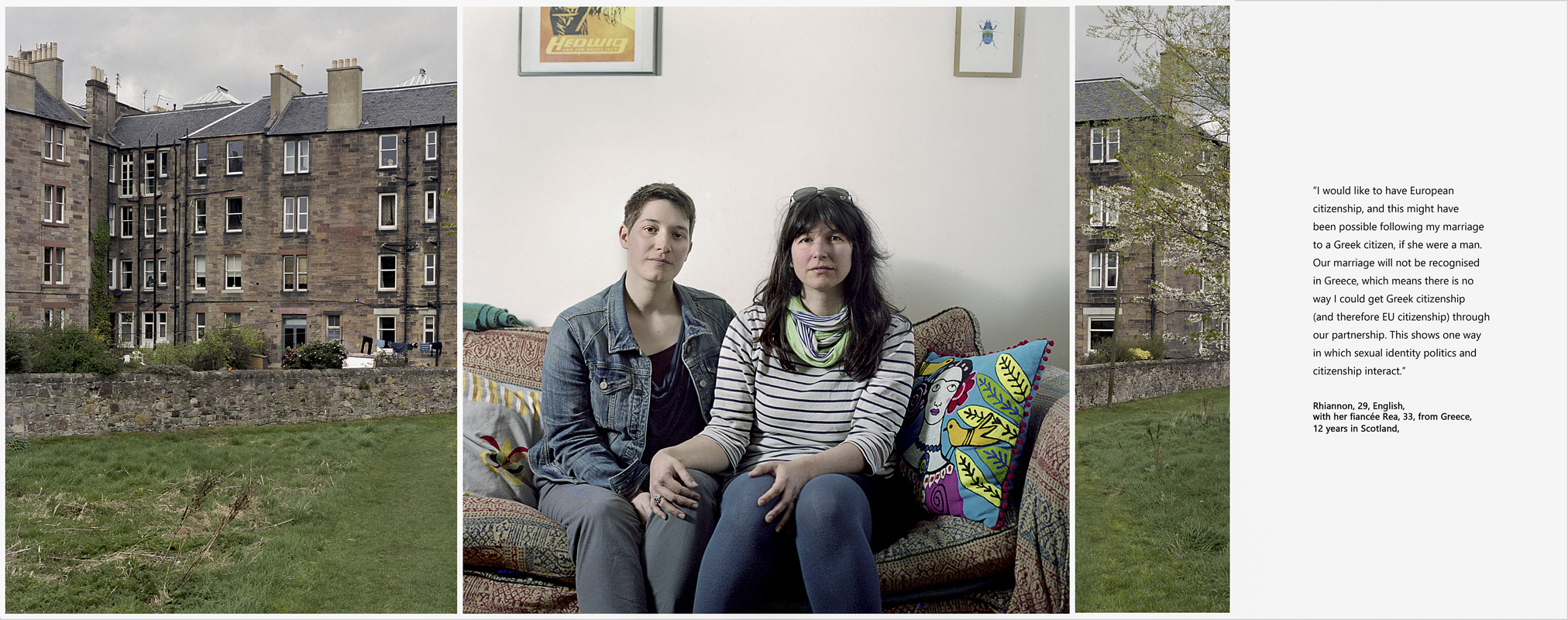
“Rea and Rhiannon” from “Waiting Room” project (2016-17) – Kat Dlugosz
Rea, 33, from Greece, 12 years in Scotland, with her fiancée Rhiannon, 29, English
I would like to have European citizenship, and this might have been possible following my marriage to a Greek citizen, if she were a man. Our marriage will not be recognised in Greece, which means there is no way I could get Greek citizenship (and therefore EU citizenship) through our partnership. This shows one way in which sexual identity politics and citizenship interact.
Kat Dlugosz is showing an image from this series in the exhibition at Bridewell Theatre.
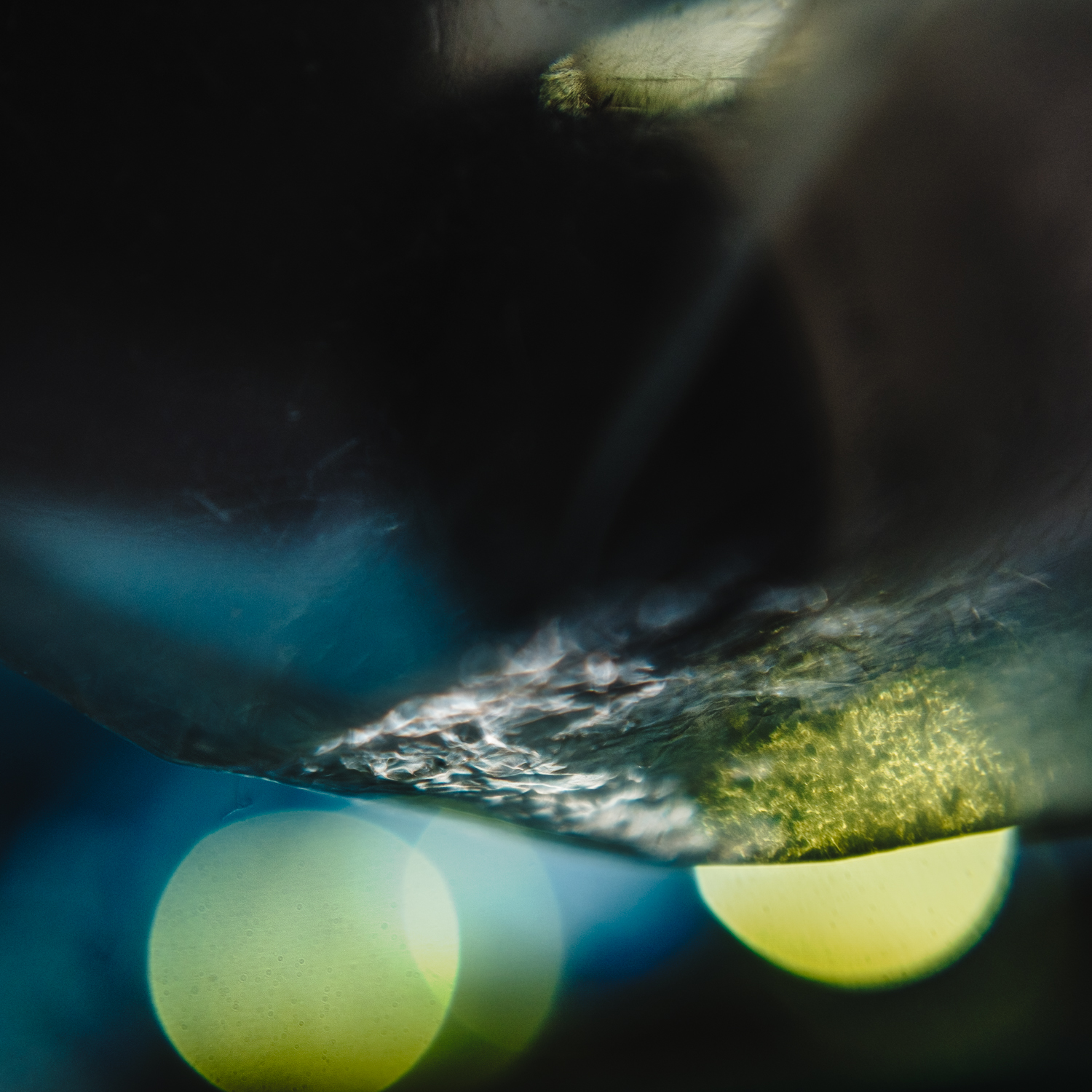
In The Broken Places – Phil Lavery
Whereas, beauty knows no boundaries, each day now starts and ends with a reminder, that there is one final border to cross.
This image is showing in the exhibition at Bridewell Theatre

The Day I Glimpsed Inside Your Soul – Silvia Maggi
The photo tells the story of thousands of people who walked through the gate of Sachsenhausen concentration camp in Oranienburg, on the outskirts of Berlin.
Sadly, for too many of them it was a one way journey. Others were lucky enough to live through it. My husband’s grandfather was one of them.
He managed to escape from the camp, a few weeks before the Red Army stormed into Berlin.
The gate represents the border between freedom and captivity, dignity and degradation, life and death.


Michelle Margaux
While traveling through Europe, recording the histories of old buildings, they seemed to tell stories within their own boundaries. The buildings have lived many lives from family chateaux, country homes and hotels to schools, mason lodges, Nazi encampments, Urbex meccas and finally ruins. Within the boundaries of these structures are many stories, energies, and identities. These significant, silent buildings are being allowed to decay and die either by feuding foreign family inheritance laws, international developers eager for their lands or simply forgotten, taken over by nature. Borders matter not to these souls, just the ones crossed to photograph them.
Michelle Margaux is showing an image from this series in the exhibition at Bridewell Theatre.
BORDERS
Bridewell Theatre Bar Gallery
St Bride Foundation, Bride Lane, Fleet Street, London, EC4Y 8EQ
www.sbf.org.uk
Opening Times:
15th January to 16th April 2018, Mon – Fri, 10am – 6pm (viewed on request at St Bride Foundation reception), 6.30pm – 11pm during theatre performances. Closed Easter Weekend.

© Nicola Jayne Maskrey


